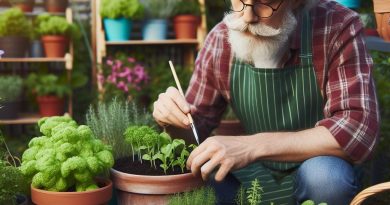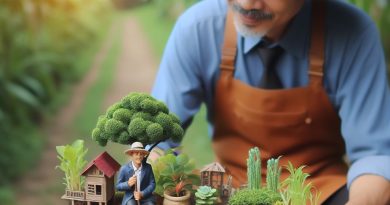Soil Health in Small Spaces: Key Tips
Last Updated on February 3, 2024
Introduction
Importance of Soil Health in Small Spaces
In small spaces, soil health is paramount for vibrant plant growth, ensuring optimal yields and sustainability.
Definition of Soil Health
Soil health encapsulates the overall well-being of soil, encompassing its physical, chemical, and biological attributes.
It signifies a dynamic ecosystem that supports plant life by fostering nutrient availability, water retention, and microbial activity.
Understanding soil health in confined spaces is crucial as these areas demand precision and efficiency in cultivation practices.
This section delves into actionable tips for maintaining and enhancing soil health in limited gardening or farming environments.
By comprehending the essence of soil health and adopting proactive strategies, individuals can transform small spaces into flourishing hubs of productivity and biodiversity.
Understanding Soil Health
Components of healthy soil
- Organic matter: It improves soil structure and nutrient-holding capacity, while supporting beneficial soil organisms.
- Soil structure: The arrangement of soil particles affects water movement, aeration, and root penetration.
- Infiltration rate: It determines how quickly water is absorbed into the soil, preventing runoff and erosion.
- Nutrient content: Essential minerals and elements nourish plants for healthy growth and development.
Significance of each component
Understanding the importance of each component is crucial for maintaining soil health in small spaces:
- Organic matter provides essential nutrients, enhances soil structure, and promotes beneficial microorganisms that aid plant growth.
- Soil structure allows for proper root development, water drainage, and air circulation, preventing compaction and waterlogging.
- Adequate infiltration rate ensures water is efficiently absorbed, reducing the risk of water runoff and soil erosion.
- Nutrient content directly influences plant health and productivity, supporting vigorous growth and resistance to diseases and pests.
By prioritizing these components, small space gardeners can optimize their soil health and ensure successful plant growth.
Read: Composting 101: Turn Waste into Garden Gold
Assessing Soil Health in Small Spaces
Assessing soil health is vital to ensure the success of any gardening endeavor, especially in small spaces where nutrient availability may be limited.
Conducting a soil test and interpreting the results provide valuable insights into the state of the soil, allowing gardeners to make informed decisions regarding fertilization and amendments.
Conducting a soil test
The first step in assessing soil health in small spaces is conducting a soil test.
This process involves collecting samples from various locations in the garden and analyzing them for pH levels and nutrient composition.
1. Importance of soil testing
Soil testing is essential because it provides valuable information about the nutrient content and pH levels of the soil.
Understanding these factors helps gardeners determine which fertilizers and amendments to use to optimize plant growth.
2. Methods of soil testing
There are different methods available for conducting a soil test.
One common method is using a soil testing kit, which typically includes a pH testing solution and nutrient testing strips.
These kits are user-friendly and provide quick results.
Another option is sending soil samples to a professional laboratory for comprehensive analysis.
This method offers a more in-depth assessment of the soil’s fertility and provides specific recommendations for improving its health.
Interpreting soil test results
Once the soil test results are obtained, it is essential to interpret them correctly to make informed decisions about soil amendments and fertilization.
1. Understanding pH levels
pH levels indicate the acidity or alkalinity of the soil.
Most plants prefer a slightly acidic to neutral pH range, typically between 6.0 and 7.0. Deviations from this range can affect nutrient availability and microbial activity.
If the soil test indicates high acidity (low pH), lime or dolomite can be added to raise the pH.
Conversely, sulfur or aluminum sulfate can be used to lower the pH if it is too alkaline.
2. Analyzing nutrient deficiencies
Soil tests also indicate nutrient deficiencies, allowing gardeners to address them with appropriate fertilizers or amendments.
Common nutrient deficiencies include nitrogen (N), phosphorus (P), and potassium (K), also known as NPK.
If a nutrient deficiency is identified, organic or synthetic fertilizers can be applied based on the recommended application rates.
Additionally, organic matter, such as compost or manure, can be incorporated into the soil to improve its nutrient-holding capacity over time.
Basically, assessing soil health in small spaces is essential for maintaining optimal growing conditions for plants.
Conducting a soil test and interpreting the results provide valuable insights into the soil’s fertility, enabling gardeners to implement appropriate amendments and fertilizers.
Regular soil testing and monitoring contribute to the long-term health and productivity of small gardens.
Read: Starting Organic Gardens: A Beginner’s Guide
Tips for Improving Soil Health in Small Spaces
Soil health is crucial for successful gardening, even in small spaces.
By implementing these key tips, you can significantly improve the quality of your soil and enhance the growth and productivity of your plants.
Adding organic matter
- Composting techniques: Composting is an effective way to add organic matter to your soil. Collect kitchen scraps, yard waste, and other organic materials and create a compost pile. Allow the materials to decompose naturally, and then spread the compost over your garden bed to enrich the soil with essential nutrients.
- Using cover crops: Cover crops are an excellent way to improve soil health in small spaces. They help prevent erosion, suppress weeds, and increase organic matter content. Choose cover crops such as legumes, grasses, or clover, and plant them in between your main crops. Once they reach maturity, you can either chop and drop them as green manure or till them into the soil.
Maintaining proper soil moisture
- Watering techniques: Proper watering techniques are vital for maintaining soil moisture in small spaces. Water deeply and less frequently to encourage deep root growth. Avoid overwatering, as it can lead to waterlogging and root rot. Consider using a drip irrigation system to deliver water directly to the plant roots and minimize water waste.
- Mulching to retain moisture: Mulching is an effective technique to retain moisture in the soil and regulate its temperature. Spread a layer of organic mulch, such as straw, wood chips, or grass clippings, around your plants. Mulch acts as a protective barrier, preventing water evaporation and reducing weed growth.
Minimizing compaction
- Proper gardening tools and techniques: Select the right gardening tools and techniques to minimize soil compaction. Use lightweight tools with ergonomic handles to reduce the pressure on the soil. Avoid stepping on garden beds and create designated pathways to access your plants without compacting the soil.
- Avoiding heavy machinery: Heavy machinery can cause significant soil compaction, especially in small spaces. Whenever possible, avoid using machinery like tractors or tillers. Instead, opt for manual or small-scale gardening methods that exert less pressure on the soil.
By adding organic matter, maintaining proper soil moisture, and minimizing compaction, you can promote soil health in small spaces.
Healthy soil provides an optimal environment for plants to thrive, leading to bountiful and successful gardening endeavors.
Read: Urban Permaculture: Sustainable Tips

Beneficial Practices for Enhancing Soil Health in Small Spaces
Crop rotation
- Crop rotation is a technique where different crops are grown in succession on the same plot of land.
- This practice helps prevent soil nutrient depletion and reduces the build-up of pests and diseases.
- By rotating crops, you can break the life cycle of specific pests that target certain plants.
- Additionally, different crops have different nutrient demands, so rotation ensures balanced nutrient uptake.
Intercropping
- Intercropping involves growing two or more crops together in the same space.
- This practice boosts soil health by maximizing space utilization, reducing weed growth, and preventing diseases.
- Certain crops, when grown together, have a symbiotic relationship where they mutually benefit from each other’s presence.
- For example, legumes fix nitrogen in the soil, benefiting neighboring crops with increased nutrient availability.
Companion planting
- Companion planting involves growing different plants in close proximity to provide mutual benefits.
- Certain plants attract pests, while others repel them. By strategically planting these together, you can deter pests.
- For instance, marigolds emit a scent that repels aphids and nematodes, effectively protecting neighboring plants.
- Companion planting also enhances soil health by improving nutrient cycling and attracting beneficial insects.
Integrated pest management
- Integrated pest management (IPM) is a holistic approach to controlling pests.
- Instead of relying solely on chemical pesticides, IPM combines multiple strategies to minimize pesticide use.
- This approach includes cultural practices like crop rotation and intercropping to naturally control pests.
- Using traps, barriers, and beneficial insects also helps reduce pest populations without harming the soil.
Implementing these beneficial practices in small spaces promotes soil health while maximizing productivity.
By rotating crops, you can prevent soil exhaustion while controlling pests and diseases naturally.
Intercropping optimizes space utilization, effectively reducing weed growth and improving nutrient availability.
Companion planting harnesses the power of plant relationships to deter pests and enhance nutrient cycling.
Integrated pest management ensures a balance between pest control and environmental sustainability.
Incorporating these practices may require careful planning and experimentation in small spaces.
Consider the specific needs and characteristics of your crops, as well as the available space.
Observe and learn from your garden to determine the most effective combination of practices.
Regular soil testing can help monitor nutrient levels and identify any potential imbalances.
Maintaining soil health in small spaces is crucial for sustainable gardening and crop production.
By adopting these beneficial practices, you can create a thriving ecosystem that supports healthy plants and abundant harvests.
Remember, a healthy soil means healthier and more resilient plants, which ultimately leads to a more successful garden.
Read: Hydroponics: Gardening Without Soil
Conclusion
Recap of key tips for maintaining soil health in small spaces
- Choose the right soil for your small space garden or farm.
- Regularly add organic matter to improve soil fertility and structure.
- Mulch to prevent soil erosion, retain moisture, and suppress weeds.
- Avoid over watering to prevent soil compaction and nutrient leaching.
- Rotate crops annually to prevent the build-up of pests and diseases in the soil.
- Monitor soil pH and nutrient levels to ensure optimal plant growth.
Importance of prioritizing soil health for sustainable gardening and farming practices
By focusing on soil health, we can enhance plant productivity, improve nutrient availability, and reduce the need for chemical fertilizers and pesticides.
Healthy soils also contribute to carbon sequestration, water conservation, and biodiversity preservation, essential for a sustainable future.
Prioritizing soil health in small spaces is an investment in the long-term viability of our gardens and farms, as well as the overall health of our ecosystems.
Overall, by implementing these key tips and recognizing the importance of soil health, we can create thriving small-space gardens and farms while contributing to the preservation and restoration of our natural environment.


